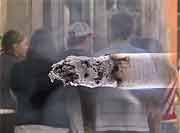
TUESDAY, Feb. 3, 2015 (HealthDay News) — Although fewer Americans are smoking and more communities have smoke-free laws, 58 million nonsmokers are still being exposed to secondhand smoke, U.S. health officials said Tuesday.
And that’s despite the fact that exposure to secondhand smoke dropped by half between 1999-2000 and 2011-12, according to new research.
The latest estimates from the U.S. Centers for Disease Control and Prevention suggest that 40 percent of children aged 3 to 11 are breathing in secondhand smoke. Among black children, that number is 70 percent, according to the CDC.
“Secondhand smoke can kill, and too many Americans — and particularly too many children — are still exposed to secondhand smoke,” Dr. Tom Frieden, director of the CDC, said during a midday press conference.
Frieden, citing the U.S. Surgeon General, said, “There is no safe level of exposure to secondhand smoke.” Tobacco smoke contains over 7,000 chemicals including about 70 that can cause cancer, he added.
Findings from the new study were published in the Feb. 3 issue of the CDC’s Morbidity and Mortality Weekly Report.
In infants and children, secondhand smoke has been linked to sudden infant death syndrome (SIDS), respiratory infections, ear infections and asthma attacks. In adult nonsmokers, passive smoke has been tied to heart disease, stroke and lung cancer, according to Frieden.
Each year, secondhand smoke kills more than 41,000 Americans from lung cancer and heart disease, and causes 400 deaths from SIDS, Frieden said. “These deaths are entirely preventable,” he added.
“The best way to reduce the harms from secondhand smoke is to reduce smoking,” Frieden said.
Harold Wimmer, president of the American Lung Association, said in a statement: “We recognize our nation can breathe more safely because of smoke-free laws the American Lung Association and our partners have worked so hard to pass these last 15 years. However, more needs to be done as one in four nonsmokers continue to be exposed to secondhand smoke, including many children.”
Frieden said smoke-free laws that prohibit smoking in public areas and in restaurants, bars and workplaces have helped dramatically to reduce exposure to secondhand smoke. Additionally, the number of U.S. households that are now smoke-free has increased in the past 20 years from 43 percent to 83 percent.
Susan Liss, executive director of the Campaign for Tobacco-Free Kids, said in a statement: “The high level of child exposure to secondhand smoke also underscores the need for parents to take additional steps to protect children, such as ensuring that homes, cars and other places frequented by children are smoke-free. For parents who smoke, the best step to protect children is to quit smoking.”
Additional findings in the report include:
- Nearly half of black Americans who don’t smoke are exposed to secondhand smoke,
- More than 40 percent of nonsmokers who live below the poverty level are exposed to secondhand smoke,
- About one-third of nonsmokers who live in rental housing are exposed to secondhand smoke.
More information
For more about secondhand smoke, visit the U.S. Centers for Disease Control and Prevention.
Copyright © 2025 HealthDay. All rights reserved.

